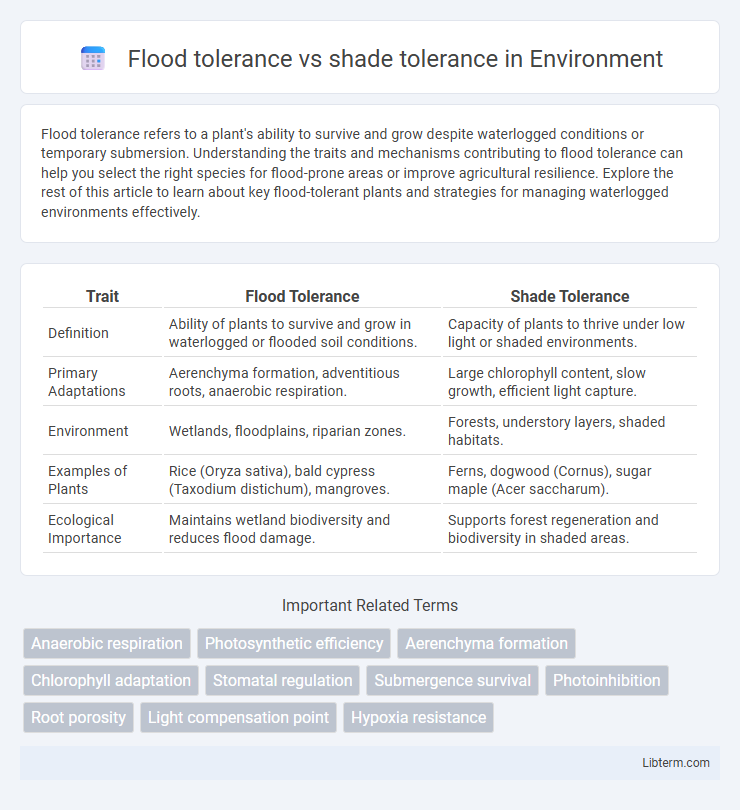Flood tolerance refers to a plant's ability to survive and grow despite waterlogged conditions or temporary submersion. Understanding the traits and mechanisms contributing to flood tolerance can help you select the right species for flood-prone areas or improve agricultural resilience. Explore the rest of this article to learn about key flood-tolerant plants and strategies for managing waterlogged environments effectively.
Table of Comparison
| Trait | Flood Tolerance | Shade Tolerance |
|---|---|---|
| Definition | Ability of plants to survive and grow in waterlogged or flooded soil conditions. | Capacity of plants to thrive under low light or shaded environments. |
| Primary Adaptations | Aerenchyma formation, adventitious roots, anaerobic respiration. | Large chlorophyll content, slow growth, efficient light capture. |
| Environment | Wetlands, floodplains, riparian zones. | Forests, understory layers, shaded habitats. |
| Examples of Plants | Rice (Oryza sativa), bald cypress (Taxodium distichum), mangroves. | Ferns, dogwood (Cornus), sugar maple (Acer saccharum). |
| Ecological Importance | Maintains wetland biodiversity and reduces flood damage. | Supports forest regeneration and biodiversity in shaded areas. |
Understanding Flood Tolerance and Shade Tolerance
Flood tolerance refers to a plant's ability to survive and grow in waterlogged or submerged soil conditions, often involving adaptations like aerenchyma tissue for oxygen transport. Shade tolerance describes a plant's capacity to thrive in low-light environments by optimizing photosynthesis and resource allocation. Understanding these tolerances aids in selecting species for specific habitats, ensuring successful growth under challenging environmental stresses.
Key Differences Between Flood and Shade Tolerance
Flood tolerance refers to a plant's ability to survive and grow in waterlogged or saturated soil conditions, often involving adaptations like aerenchyma tissues or shallow root systems. Shade tolerance describes a plant's capacity to thrive under low light intensity, typically featuring traits such as larger, thinner leaves and slow growth rates to maximize photosynthesis efficiency. The key difference lies in environmental stressors: flood-tolerant species adapt to excess water and oxygen deprivation, while shade-tolerant species adjust to limited light availability for optimal energy capture.
Physiological Mechanisms of Flood Tolerance
Flood tolerance in plants involves specialized physiological mechanisms such as aerenchyma formation, which facilitates oxygen transport to submerged roots, and the activation of anaerobic respiration pathways to sustain energy production under hypoxic conditions. These adaptations reduce oxidative stress and maintain cellular homeostasis during prolonged waterlogging. In contrast, shade tolerance primarily relies on optimizing photosynthetic efficiency and chlorophyll concentration to capture limited light, without requiring extensive metabolic changes for oxygen deficiency.
Adaptations Underlying Shade Tolerance
Shade tolerance in plants is primarily governed by adaptations such as large, thin leaves with high chlorophyll content that maximize light capture in low-light environments. These plants often exhibit slower growth rates and enhanced photosynthetic efficiency to thrive under forest canopies. Conversely, flood tolerance involves physiological traits like aerenchyma formation and anaerobic respiration, which are distinct from the structural and functional adaptations seen in shade-tolerant species.
Environmental Factors Influencing Tolerance Levels
Flood tolerance and shade tolerance in plants are significantly influenced by environmental factors such as soil moisture, light intensity, oxygen availability, and temperature variations. High soil moisture and low oxygen levels favor flood-tolerant species, while shaded environments with limited sunlight promote shade-tolerant adaptations like larger leaf surface areas and efficient photosynthesis. Understanding these factors helps in predicting plant distribution patterns and managing ecosystems prone to flooding or dense canopy cover.
Flood vs. Shade Tolerance: Species Comparison
Flood tolerance and shade tolerance vary significantly among plant species, affecting their survival and growth in diverse ecosystems. Species like bald cypress (Taxodium distichum) exhibit high flood tolerance, thriving in waterlogged soils, while shade-tolerant species such as sugar maple (Acer saccharum) excel under low light conditions but typically cannot withstand prolonged flooding. Understanding these tolerances is crucial for selecting appropriate species in habitat restoration and urban planning to ensure ecosystem resilience.
Impacts on Plant Distribution and Ecosystems
Flood tolerance influences plant distribution by enabling species to survive in waterlogged or periodically inundated habitats, shaping wetland and riparian ecosystems with specialized vegetation. Shade tolerance affects where plants thrive under canopy cover, determining understory composition and biodiversity in forest ecosystems. The interaction of these tolerances drives plant community structure and ecosystem resilience, particularly in environments with variable light and moisture conditions.
Strategies for Enhancing Tolerance in Crops
Flood tolerance and shade tolerance in crops involve distinct physiological and genetic adaptations that can be enhanced through targeted breeding and biotechnological approaches. Enhancing flood tolerance often requires traits such as aerenchyma formation, adventitious root development, and anaerobic metabolism genes, while improving shade tolerance focuses on optimizing photosynthetic efficiency and leaf morphology under low light conditions. Advanced strategies include CRISPR gene editing for precise trait integration, marker-assisted selection for rapid breeding cycles, and employing growth regulators to modulate stress responses for crops like rice, soybean, and maize.
Implications for Forest and Wetland Management
Flood tolerance and shade tolerance play critical roles in determining species composition and succession in forest and wetland ecosystems, influencing biodiversity and resilience. Species with high flood tolerance thrive in waterlogged soils and periodic inundation, essential for maintaining wetland habitat stability, while shade-tolerant species dominate understory layers, affecting light availability and competition dynamics. Effective forest and wetland management must integrate these tolerance traits to optimize restoration efforts, enhance habitat quality, and support ecosystem services under changing environmental conditions.
Future Research Directions in Plant Tolerance Traits
Future research in plant tolerance traits should emphasize the genetic and molecular mechanisms underlying flood tolerance and shade tolerance to enhance adaptive breeding strategies. Investigating the cross-talk between flood response pathways and shade avoidance signals can reveal novel traits for improving resilience in fluctuating environments. Integrating high-throughput phenotyping with multi-omics approaches will accelerate the identification of key regulators for simultaneous flood and shade tolerance in crops.
Flood tolerance Infographic

 libterm.com
libterm.com